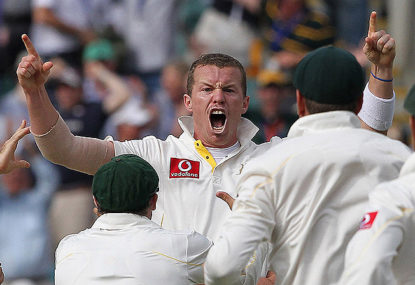'This is the Starc comeback!' Mitchell back to his best, demolishes Mumbai in barnstorming over
As wife Alyssa Healy watches on, Mitchell Starc was back in form, taking three wickets in an over including the dangerous Tim David, to…

Upon arriving on South African soil Michael Clarke confidently claimed “this Australian attack is the best in the world”.
As with any captain it is Clarke’s role to talk up his team’s chances, he is hardly going to proclaim the Proteas bowling attack untouchable and that the Australian bowlers are unlikely to challenge them over the three-Test series.
However, is Clarke’s statement just overconfident posturing or is there an element of truth to it?
Using the recent Ashes series as a gauge Clarke could be well within his right to make such a claim. The English batting line-up, arguably the most settled in the world in November last year, was comprehensively routed.
On six occasions they were dismissed for less than 200 on pitches which, with proper application, were conducive to high scores. The bowling attack, for the first time in Australian ashes history, remaining unchanged throughout the series.
Leading the attack was Mitchell Johnson, Australia’s newest moustachioed menace, who combined aggression, pace and (at times) surprising accuracy to claim 37 English scalps at an average of 13.97.
He was accompanied by two able lieutenants in Ryan Harris (22 wickets at 19.31) and Peter Siddle (16 at 24.12) who both had an uncanny knack throughout the series of making crucial breakthroughs whenever the English had a sniff.
Rounding off the attack is Nathan Lyon (19 at 29.36) who after temporarily, and some argue inexplicably, ceding his position to Glenn Maxwell in India and Ashton Agar in England has cemented his place in the Australian team for the foreseeable future.
Going into this series, however, the Australian pace bowling attack could not be considered in the same class as South Africa. Dale Steyn, now 30, has taken 350 Test wickets at an average under 23.
His figures of 6 for 8 against Pakistan at the Wanderers last year will be remembered as one of the all-time great bowling efforts and is testament to a man who will finish his career as one of history’s greatest fast bowlers.
He is currently ranked second in the ICC Test Bowling rankings. The man who recently replaced him, Vernon Philander, has 105 Test wickets at an astonishing average of 18, proving that a consistently aiming to hit the top of off-stump will always get wickets.
The third prong in the pace attack is Morne Morkel who, at 6 foot 6, has used his ability to extract pace and bounce to great success claiming 183 wickets at a touch under 30.
Since 2010, South Africa have dismissed four teams, Pakistan twice and New Zealand and Australia once, for fewer than 100 (three of these scores were less than 50).
One area where Australia hold an indisputable advantage is in the spin department.
Nathan Lyon is now regarded as one of the world’s pre-eminent spin bowlers. The first Australian spinner to claim 100 Test wickets since the retirement of Warne and MacGill, he has proved himself in Australian, English and Indian conditions.
By contrast, South Africa has continued its perpetual struggle to find their first world class spin bowler since Hugh Tayfield.
Imran Tahir, despite some success in the UAE, averages over 40 while Robin Peterson is more of an all-rounder than spin bowler capable of dominated a batting attack.
If Australia is to challenge South Africa Nathan Lyon must assert himself on the series.
This Australian bowling attack is the most settled it has been since England was last whitewashed in 2006/07.
Mitchell Johnson (8), Peter Siddle (6) and Ryan Harris (3) are all ranked among the Top 10 Test bowlers in the world while Australian self-confidence is the highest it’s been in half a decade.
However, one successful series against an underperforming English team does not make a world class bowling attack.
Though the Australian bowling attack is undoubtedly talented it cannot (for this moment at least) be considered the best in the world. It must first prove itself against the world’s best batting line-up.
A successful tour over the next two months could, however, prove Clarke’s confident statement to be true.